2. 中国航天科工第六研究院41所, 内蒙古 呼和浩特 010010
2. 41st Branch of Sixth Research Institute of Aerospace Industry and Technology, Huhehaote 010010, China
底排药剂通常由氧化剂、可燃剂与粘合剂组成, 燃烧可产生大量的高温、小分子量的气体, 且具有燃速低的特点[1]。底部排气弹的增程原理是利用底排药剂在低压环境燃烧, 不断向弹底排放高温燃气, 通过添质加能的方式提高弹底压力, 达到减小底阻而增加射程的目的[2]。高氯酸铵(AP)基端羟基聚丁二烯(HTPB)复合推进剂具有燃烧稳定的优点, 广泛应用于火箭与导弹的发动机。目前, 关于AP基固体火箭推进剂的燃烧特性研究的比较多[3-5], 不同工况下的热特性数据相对比较完善。然而, AP/HTPB底排推进剂要求的燃速较低, 工作时间长, 通常采用调节AP颗粒粒度分布、级配以及AP/HTPB的质量分数来实现。近年来, 寻求新型的底排药柱结构、点火方式, 深入了解底排推进剂强非稳态燃烧特性,提高底排推进剂点火与燃烧的一致性成为重要的研究方向[6]。AP/HTPB底排推进剂的比热容及导热系数是其重要的两个热特性参数, 对其点火与燃烧有一定影响。国内外关于AP颗粒、HTPB颗粒以及特定配比的AP/HTPB推进剂的比热容和导热系数都有重要的研究结果[7-10], 但经历长期老化的底排药剂热特性参数未见报道, 且对研究其燃烧可靠性与性能评价又是必需的。关于底排药剂的点火与燃烧的以往研究, 通常采用参数符合的方法来获得并进行数值计算[11-13]。为此, 本研究对155 mm底排弹历经自然老化(密封室温存20余年)的AP/HTPB底排药剂的比热容与导热系数进行实验研究。
2 实验部分 2.1 试剂与仪器实验样品取自某155 mm底排装置在高速旋转终止燃烧实验结束后剩余的AP/HTPB底排药柱, 该药柱密封保存与自然老化至今有20余年, 如图 1所示。
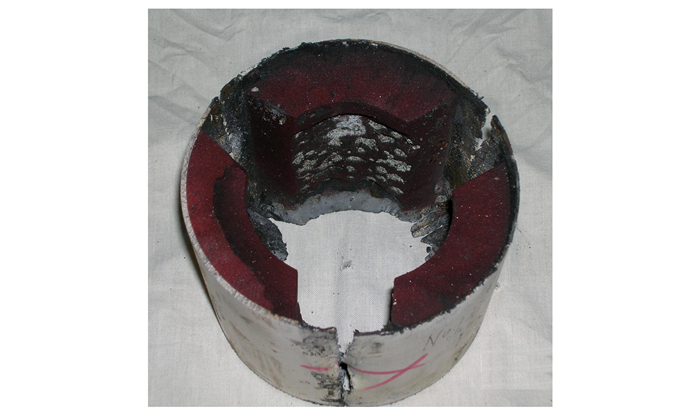
|
图 1 底排推进剂样品 Fig.1 Base bleed propellant sample |
仪器:德国OXFORD Instrument JEM 2000CX型扫描电镜(SEM); 日本新型DSC1型差示扫描仪, 温度范围: -35~500 ℃; 温度精度: ±0.02 ℃; 炉温分辨率: ±0.00008 ℃; 升温速率0.02~300 ℃·min-1:传感器类型: FRS5;传感器材料:陶瓷; 热电偶数量: 56对; 量热灵敏度: 0.04 μW; 量热准确度: 1%;量热精度: 0.1%;最大数据采集速率: 50个/s; QuickLine-10TM导热仪, 测量原理如图 2所示, 标准样:不锈钢304 L和高温玻璃。
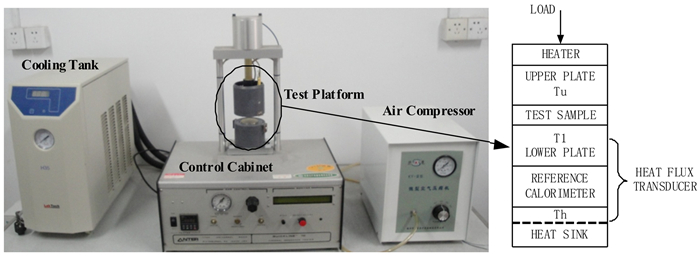
|
图 2 导热仪及测量原理图 Fig.2 Conductometer and measurement principle |
实验样品热阻采用(1)式[14]计算:
| ${R_{\rm{s}}} = F[({T_{\rm{u}}} - {T_1})/({T_1} - {T_{\rm{h}}})] - {R_{{\mathop{\rm int}} }}$ | (1) |
式中, Rs为样品的热阻, Rs=d/λ, m2·K·W-1; d为样品厚度, m; λ为样品导热系数, W·m-1·K-1; F=1/λ0, W-1·m·K, λ0为参考量热计的导热系数, W·m-1·K-1; ΔTs=Tu-T1, ΔTr=T1-Th, Tu为样品上表面温度, K; T1为样品下表面的温度, K; Th散热片的温度, K; Rint样品和两个金属接触面间总的接触热阻, m2·K·W-1。通过测量三组标准样的导热系数, 即可确定斜率F以及接触热阻Rint, 进而可以确定样品的导热系数λ。
2.2 实验过程 2.2.1 粒度分析AP颗粒分布及AP/HTPB含量比率对比热容及导热系数均有影响, 为方便对比分析, 取图 1中的部分样品制作断面2 cm×2 cm的条形试样进行电镜扫描, 如图 3所示; 采用图象处理技术并基于颗粒等效直径理论[15], 发现底排药剂中的AP颗粒为两级配比, 平均当量直径分别为103, 118 μm, 标准差为13 μm, 组分质量比约为: mAP/mHTPB≈78/22。
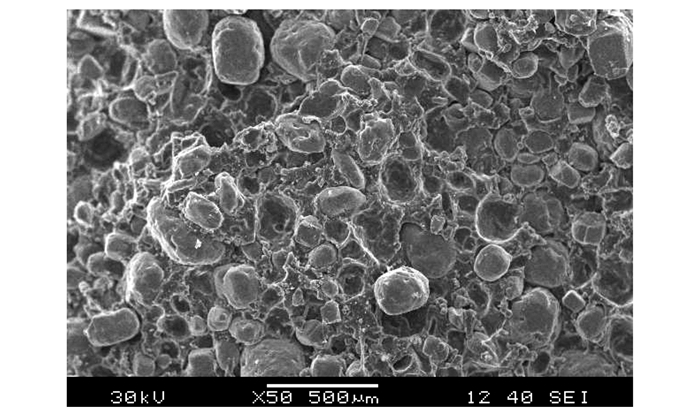
|
图 3 底排药剂扫描电镜图 Fig.3 SEM inphoto of base bleed propellant |
含能材料的比热容测量普遍采用微热量热法, 其缺点是仅能测量-40~50 ℃的范围, 且操作麻烦[15]。目前, 差示扫描量热法(DSC)测定材料的比热容具有快速、方便、精度高、温度范围广, 并能获得比热容与温度的关系等优点, 广泛应用于各种材料比热容的测定[16-18]。本实验在高纯N2气环境, 流速50 mL·min-1, 温度范围: 25~500 ℃, 升温速率: 20 ℃·min-1。按文献[19]将底排药剂制成小块状, 质量: 1.28 mg, 并对试样进行干燥, 保常温处理。实验所获得的DSC曲线如图 4所示。由DSC曲线计算所得的比热容随温度的变化情况如图 5所示, 平均比热容为0.9868 kJ·kg-1·℃-1。
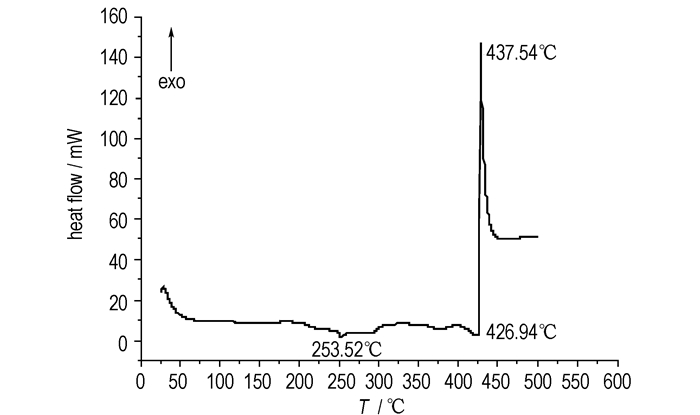
|
图 4 底排药剂的DSC曲线 Fig.4 DSC curve of base bleed propellant |
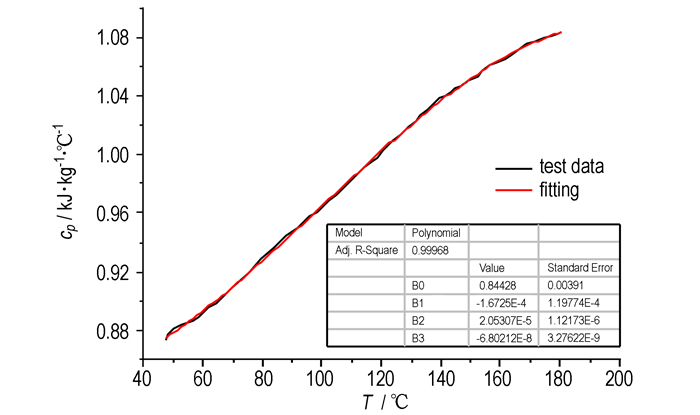
|
图 5 比热容与温度的关系(40~180 ℃) Fig.5 Specific heat capacity v.s. temperature(40~180 ℃) |
首先将试样制作成Φ25 cm厚度分别为0.4404 cm与0.5748 cm圆饼状, 将其放在恒温为15 ℃的环境内24 h, 确保初温均匀一致; 随后, 对标准试样不锈钢304 L、两种厚度的耐温玻璃(导热系数应该相同, 因厚度不一样, 故存在测量误差是容许的)的导热系数进行测量, 分别测试三组, 并确定斜率与斜距, 实验数据见表 1; 最后, 对两种不同厚度底排药剂试样(A、B)也进行三组测试, 实验数据见表 2。计算导热系数平均值为0.2292 W·m-1·K-1, 方差为0.1877 W·m-1·K-1。
| 表 1 标准样实验数据 Tab.1 Test data of standard samples |
| 表 2 底排药剂实验数据 Tab.2 Test data of base bleed propellant(BBP) samples |
对于AP/HTPB复合底排推进剂, AP组分的含量往往大于HTPB组分的含量, 则使得AP更够在较少燃料的情况下维持放热反应, 也因此可将AP认为是初期稠密相反应过程的控制因素[21]。文献[21]采用DSC研究了AP(纯度: > 99%, 粒径: 30~40 μm)的热分解特性, 在加热速率为20 K·min-1情况下(不同的加热速率吸热与放热最大温度都是不一样的), 测得AP最大吸热温度约为247 ℃, 最大放热温度约为441 ℃。由图 4可知, 底排药剂试样的最大吸热温度约为253.52 ℃, 最大放热温度约为437.54 ℃。两者的最大吸热温度与最大放热温度非常接近, 故AP/HTPB复合底排推进剂中AP占主导因素, 且放热反应温度与老化之间是不相关的, 但从文献[22]可以看出, 老化的AP/HTPB复合推进剂的放热最高温度略低于未经老化的(老化方式为实验室温度循环加速老化实验)。
图 5反映了AP/HTPB复合底排推进剂(老化)比热容与温度的关系(40~180 ℃), 多项式拟合关系式为:
| ${c_p} = {B_0} + {B_1}T + {B_2}{T^2} + {B_3}{T^3}$ | (2) |
关于纯固相AP与纯固相HTPB的比热容, 与温度之间有如下关系[7-8]:
| ${c_{p,{\rm{AP}}}} = 0.586 + 1.715 \times {10^{ - 3}}T$ | (3) |
| ${c_{p,{\rm{HTPB}}}} = 1.046 + 0.356 \times {10^{ - 2}}T$ | (4) |
因此, 对于AP/HTPB复合推进剂(未经老化), 假定AP与HTPB的质量百分比分别为a与b, 则:
| ${c_{p,{\rm{AP/HTPB}}}} = a\cdot{c_{p,{\rm{AP}}}} + b\cdot{c_{p,{\rm{HTPB}}}}$ | (5) |
拟合公式(2)与公式(5)在温度范围10 ℃≤T≤180 ℃的计算对比如图 6所示。经过老化的AP/HTPB复合底排推进剂的比热容大于未经老化的, 在低温段, 误差相对更大。
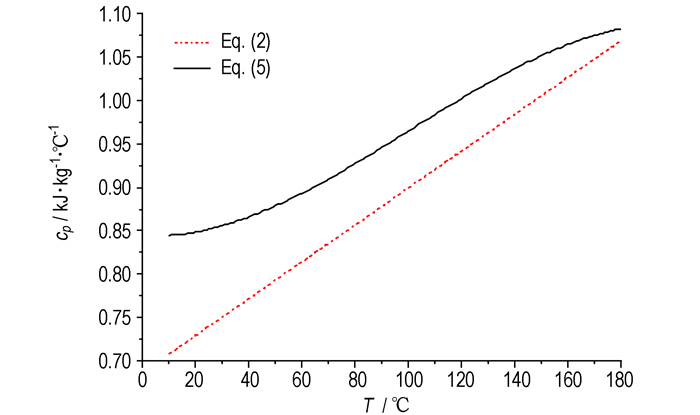
|
图 6 老化的与未老化的AP/HTPB复合底排推进剂的比热容对比 Fig.6 Comparison of specific heat capacity between aged and un-aged AP/HTPB composite base bleed propellant |
由表 2可计算出经老化的AP/HTPB底排药剂试样热导率平均值λ=0.2292 W·m-1·K-1, 未经老化的底排药剂热导率为λ=0.402 W·m-1·K-1(常温: 15 ℃, 平均意义上的)[6], 经历自然老化的底排药剂热导率减小了约43%。
4 结论采用差示扫描量热法(DSC)测得某155 mm底排弹历经自然老化的AP/HTPB底排药剂分解过程中最大吸热温度为253.52 ℃, 最大放热温度为437.54 ℃; 与纯AP颗粒DSC实验分解峰温(吸热: 247 ℃; 放热: 441 ℃)基本一致, 表明AP颗粒在底排药剂热分解过程占主导作用; 基于DSC实验, 得到了底排药剂比热容与温度的变化关系, 比热容平均值为0.9868 kJ·kg-1·℃-1; 测得导热系数平均值为0.2292 W·m-1·K-1, 方差为0.1877 W·m-1·K-1; 与未老化药剂相比, 比热容略有增大, 而导热系数减小约43%, 因此, 由传热学理论可知热扩散系数减小, 从而导致点火延迟时间增长。
| [1] |
GJB 5471. 18-2005: 烟火药设计手册-第18部分: 底部排气剂[S]. 国防科学技术工业委员会, 2005.
|
| [2] |
郭锡福.
底部排气弹外弹道学[M]. 北京: 国防工业出版社, 1995.
|
| [3] |
赵瑜, 鲍福廷, 胡志伟, 等. AP /HTPB复合推进剂燃烧的详细化学动力学建模[J].
固体火箭技术, 2012, 35(3): 311-318. ZHAO Yu, BAO Fu-ting, HU Zhi-wei, et al. A combustion model for AP /HTPB composite propellant using detailed chemical kinetics[J]. Journal of Solid Rocket Technology, 2012, 35(3): 311-318. |
| [4] |
Groult S, Bizot A. Numerical simulation of heterogeneous AP/HTPB propellant combustion[R], AIAA 2004-4039, 2004.
|
| [5] |
Bizot A. Numerical simulations of heterogeneous AP/HTPB propellant combustion with aluminium[R], AIAA 2006-5096, 2006.
|
| [6] |
陆春义. 底排装置强非稳态燃烧特性研究[D]. 南京: 南京理工大学, 2009.
LU Chun-yi. Study on characteristics of unstable combustion of base bleedunit[D]. Nanjing: Nanjing University of Science and Technology, 2009. http://cdmd.cnki.com.cn/Article/CDMD-10288-2010098958.htm |
| [7] |
Jeppson M B, Beckstead M W, Jing Q. A kinetic model for the premixed combustion of a fine AP/HTPB composite propellant[R], AIAA-A9816318, 1998.
|
| [8] |
Tanaka M, Yokosuka, Beckstead M W. A Three phase combustion model of ammonium perchlorate[R], AIAA 96-2888, 1996.
|
| [9] |
Goncalres R F B, Silva R P, Rocco J A, et al. Thermal Decomposition kinetics of aged solid propellant based on ammonium perchlorate AP/HTPB binder[R], AIAA 2008-4969, 2008.
|
| [10] |
Lee I. Thermal response of AP and aluminized AP/HTPB-based propellants with varing composition[R], AIAA 99-2496, 1999.
|
| [11] |
周彦煌, 张领科, 陆春义, 等. 一种两相流点火模型及数值模拟[J].
兵工学报, 2010, 31(4): 414-418. ZHOU Yan-huang, ZHANG Ling-ke, LU Chun-yi, et al. A two-phase flow model and numerical simulation of ignition[J]. Acta Armamentarii, 2010, 31(4): 414-418. |
| [12] |
张领科, 周彦煌, 赵威. 膛内高温燃气对底排药剂点火过程影响的数值分析[J].
南京理工大学学报, 2010, 34(6): 770-774. ZHANG Ling-ke, ZHOU Yan-huang, ZHAO Wei. Numerical analysis on effect of high temperature gas in bore on ignition process of base bleed propellant[J]. Chinese Journal of Nanjing University of Science and Technology(Natural Science), 2010, 34(6): 770-774. |
| [13] |
张领科, 周彦煌, 余永刚. 底排点火具射流特性对点火延迟时间的影响[J].
弹道学报, 2010, 22(3): 8-11. ZHANG Ling-ke, ZHOU Yan-huang, YU Yong-gang. Effect of jet of base bleed igniter on ignition delay time[J]. Chinese Journal of Ballistics, 2010, 22(3): 8-11. |
| [14] |
杨世铭, 陶文铨.
传热学(第四版)[M]. 北京: 高等教育出版社, 2006.
YANG Shi-ming, TAO Wen-quan. Heat transfer[M]. Beijing: Higher Education Press, 2006 |
| [15] |
GJB 770B-2005: 火药试验方法[S]. 国防科学技术工业委员会, 2005.
|
| [16] |
刘子如.
含能材料热分析[M]. 北京: 国防工业出版社, 2008.
LIU Zi-ru. Thermal Analyses for Energetic Materials[M]. Beijing: National Defence Industry Press, 2008 |
| [17] |
孙翠娜, 乔小晶, 张同来, 等. 用差示扫描量热法测定含能化合物的比热容[J].
含能材料, 2001, 24(3): 1-5. SUN Cui-na, QIAO Xiao-jing, ZHANG Tong-lai, et al. Determination of specific heat capacity of energetic compounds by DSC[J]. Chinese Journal of Energetic Materials(Hanneng Cailiao), 2001, 24(2): 1-5. |
| [18] |
陈珣, 傅培舫, 周怀春. 煤焦比热容的模型与DSC实验研究[J].
工程热物理学报, 2008, 31(1): 169-172. CHEN Xun, FU Pei-fang, ZHOU Huai-chun. Experimental study of specific heat models of coal-chars by applying DSC[J]. Journal of Engineering Thermophysics, 2008, 31(1): 169-172. |
| [19] |
GJB/J 5128-2002, 火炸药用热导率、比热、线膨胀系数标准物质规范[S]. 国防科学技术工业委员会, 2002.
|
| [20] |
刘建勋, 刘永, 张小娟, 等. 纳米NiO /CNTs复合粒子的制备及其对AP和AP /HTPB热分解的影响[J].
推进技术, 2008, 29(1): 119-123. LIU Jian-xun, ZHANG Yong, ZHANG Xiao-juan, et al. Preparation of NiO/CNTs composites and their effects on the thermal decomposition of AP and AP/HTPB[J]. Chinese Journal of Propulsion Technology, 2008, 29(1): 119-123. |
| [21] |
ZHU Yan-li, HUANG Hao, REN Hui, et al. Kinetics of thermal decomposition of ammonium perchlorate by TG/DSC-MS-FTIR[J].
International Journal of Energetic Materials, 2014, 32: 16-26. DOI:10.1080/07370652.2012.725453 |
| [22] |
CAI Wei-dong, THAKRE Piyush, YANG Vigor. A model of AP/HTPB composite propellant combustion in rocket-motor environments[J].
Combustion Science and Technology, 2008, 180: 2143-2169. DOI:10.1080/00102200802414915 |
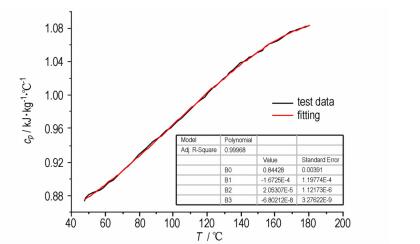
The specific heat capacity and conductivity coefficient for unaged and naturally aged (stored in a sealed plastic bag under room temperature) AP/HTPB base bleed propellant used in a 155 mm base bleed projectile were determined by differential scanning calorimeter (DSC) and conductometer.



